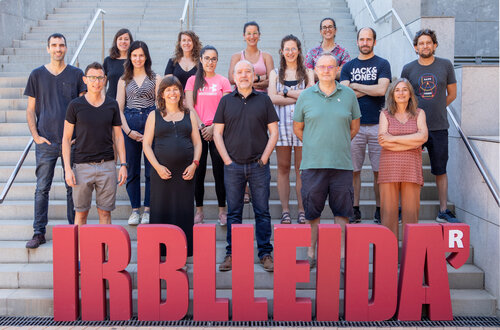New research in Lleida to advance the study of neurodegenerative diseases
Made with mouse models that reproduce part of the disease Amyotrophic Lateral Sclerosis
The mouse model of the neurodegenerative motor neuron disease, which reproduces part of amyotrophic lateral sclerosis (ALS), shows a non-canonical profile of senescence biomarkers. This means that it does not show the typical pattern of cellular ageing (called senescence), according to research carried out in Lleida. This study provides a better understanding of the relationship between ageing and the neurodegeneration present in ALS. This is the recent finding published in the journal Disease Models and Mechanisms.
"These findings demonstrate that there are common molecular bases in ALS and ageing, but that they do not manifest as they do in other neurodegenerative diseases. For example, our work suggests that there are very marked neuroinflammatory factors in ALS, and that the so-called senolytic treatments, aimed at reducing the consequences of cellular senescence, which have been useful in other neurodegenerative models, do not have the same response in the ALS model. In addition, we have been able to relate the atypical senescence of this model to problems in ribonucleic acid metabolism, which opens up a potential new avenue of treatment," explained researcher Pascual Torres, first author of the article.
Senescence is a process involved in ageing, which involves stopping cell division, and is implicated in the defence against the generation and development of tumours. With ageing, an excess of this process would be counterproductive. This "classical" senescence can be measured by different markers. In models of other age-related neurodegenerative diseases, such as Alzheimer's or Parkinson's, it has been proven that "classical" senescence is involved in the pathological process, since the markers are more or less fully manifested. In the case of the ALS mice studied, the markers do not fit the definition of "classical" senescence, configuring what could be an alternative senescence process.
The research, led by the Metabolic Pathophysiology research group at the University of Lleida (UdL) and the Institute for Research in Biomedicine of Lleida (IRBLleida), has involved the collaboration of researchers from the Oncogenic and Developmental Senescence group also at the UdL and IRBLleida, the Functional Unit of Amyotrophic Lateral Sclerosis (UFELA) of the Neurology Service of the University Hospital of Bellvitge, the Department of Pathology and Experimental Therapeutics of the University of Barcelona and the Centre for Biomedical Research Network on Neurodegenerative Diseases (CIBERNED).
Ageing is an important risk factor for developing amyotrophic lateral sclerosis (ALS), a neurodegenerative disease characterised by the loss of motor neurons. Senescence, the ageing of cells, plays a major role in ALS. For this reason, to study the possible involvement of senescence-associated phenomena in ALS, the research team has explored the profile of senescence biomarkers in a mouse model.
"This study is important because it provides a better understanding of the relationship between ageing and the neurodegeneration present in ALS. It can be proposed that ALS, by some accounts, is a form of accelerated ageing by motor neurons and supporting cells. Our findings help to refine this relationship between ageing and ALS, helping to design, in the future, therapeutic strategies that take into account the specificities of the disease" confirmed the UdL professor and principal investigator, Manel Portero.
This research has been possible thanks to funding from the Instituto de Salud Carlos III (PI 17-000134, PI 20-0155), the Generalitat de Catalunya (2017SGR696), the Ministry of Science, Innovation and Universities (BFU2017-83646-P, AEI, ERDF, EU), the European Union-Next Generation EU funds (Margarita Salas fellow), FUNDELA Ajuda, RedELA-Plataforma Investigación and the Fundació Miquel Valls (Jack Van den Hoek donation) and the ERDF fund ("A way to make Europe").
Article: Torres P, Anerillas C, Ramírez-Núñez O, Fernàndez A, Encinas M, Povedano M, Andrés-Benito P, Ferrer I, Ayala V, Pamplona R, Portero-Otín M. The motor neuron disease mouse model hSOD1-G93A shows a non-canonical profile of senescence biomarkers. Dis Model Mech. 2022 Aug 2:dmm.049059. doi: 10.1242/dmm.049059. Epub ahead of print. PMID: 35916061.

The Metabolic Pathophysiology group has led the research






